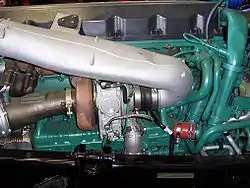Variable-geometry turbocharger
Variable-geometry turbochargers (VGTs), occasionally known as variable-nozzle turbines (VNTs), are a type of turbochargers, usually designed to allow the effective aspect ratio of the turbocharger to be altered as conditions change. This is done because the optimum aspect ratio at low engine speeds is very different from that at high engine speeds.
If the aspect ratio is too large, the turbo will fail to create boost at low speeds; if the aspect ratio is too small, the turbo will choke the engine at high speeds, leading to high exhaust manifold pressures, high pumping losses, and ultimately lower power output. By altering the geometry of the turbine housing as the engine accelerates, the turbo's aspect ratio can be maintained at its optimum. Because of this, VGTs have a minimal amount of lag, a low boost threshold, and high efficiency at higher engine speeds.
 A cut open VGT turbocharger (VW Golf, Diesel)
A cut open VGT turbocharger (VW Golf, Diesel) Exhaust side with variable-geometry guide vanes
Exhaust side with variable-geometry guide vanes charge air side with compressor wheel
charge air side with compressor wheel Turbo shaft storage
Turbo shaft storage Turbo shaft storage
Turbo shaft storage
History
The rotating-vane VGT was first developed under Garrett and patented in 1953.[1]
One of the first production cars to use these turbochargers was the 1988 Honda Legend; it used a water-cooled VGT installed on its 2.0-litre V6 engine.
The limited-production 1989 Shelby CSX-VNT, with only 500 examples produced, was equipped with a 2.2-litre Chrysler K engine with a Garrett turbo called the VNT-25 (because it used the same compressor and shaft as the fixed-geometry Garrett T-25).
In 1991, Fiat incorporated a VGT into the Croma's direct-injected turbodiesel.[2]
The Peugeot 405 T16, launched in 1992, used a Garrett VAT25 variable-geometry turbocharger on its 2.0-litre 16-valve engine.
The 2007 Porsche 911 Turbo has twin variable-geometry turbochargers on its 3.6-litre horizontally-opposed six-cylinder gasoline engine.
The 2015 Koenigsegg One:1 (named after its power-to-weight ratio of 1:1) uses twin variable-geometry turbochargers on its 5.0-litre V8 engine, allowing it to produce 1361 horsepower.
Common designs
The two most common implementations of VGTs are as follows:
For light-duty engines (passenger cars, race cars, and light commercial vehicles), the turbine's vanes rotate in unison, relative to its hub, to vary its pitch and cross-sectional area.
For heavy-duty engines, the vanes do not rotate, but instead, their effective width is changed. This is usually done by moving the turbine along its axis, partially retracting the vanes within the housing. Alternatively, a partition within the housing may slide back and forth. The area between the edges of the vanes changes, leading to a variable-aspect-ratio system with fewer moving parts.[3]
VGTs may be controlled by a membrane vacuum actuator, electric servo, 3-phase electric actuation, hydraulic actuator, or pneumatic actuator using air brake pressure.
Unlike fixed-geometry turbines, VGTs do not require a wastegate.
Use
VGTs tend to be much more common on diesel engines, as lower exhaust temperatures mean they are less prone to failure. Early gasoline-engine VGTs required significant pre-charge cooling to extend the turbocharger life to reasonable levels, but advances in technology have improved their resistance to high-temperature gasoline exhaust, and they have started to appear increasingly in gasoline-engined cars.
Typically, VGTs are only found in OEM applications due to the level of coordination required to keep the vanes in the most optimal position for whatever state the engine is in. However, there are aftermarket VGT control units available, and some high-end aftermarket engine management systems can control VGTs as well.
In trucks, VGTs are also used to control the ratio of exhaust recirculated back to the engine inlet (they can be controlled to selectively increase the exhaust manifold pressure until it exceeds the inlet manifold pressure, which promotes exhaust gas recirculation). Although excessive engine backpressure is detrimental to overall fuel efficiency, ensuring a sufficient EGR rate even during transient events (such as gear changes) can be sufficient to reduce nitrogen oxide emissions down to that required by emissions legislation (e.g., Euro 5 for Europe and EPA 10 for the USA).
Another use for sliding-vane turbochargers is as a downstream exhaust brake, so that an extra exhaust throttle valve is not needed. The mechanism can also be deliberately modified to reduce the turbine efficiency in a pre-defined position. This mode can be selected to sustain a raised exhaust temperature to promote "light-off" and "regeneration" of a diesel particulate filter (this involves heating the carbon particles stuck in the filter until they oxidize away in a semi-self-sustaining reaction - rather like the self-cleaning process some ovens offer). Actuation of a VGT for EGR flow control, or to implement braking or regeneration modes in general, requires hydraulic actuators or electric servos.
Manufacturers
Several companies manufacture and supply rotating-vane variable-geometry turbochargers, including Garrett, BorgWarner, and Mitsubishi Heavy Industries. This design is mostly limited to small engines and light-duty applications (passenger cars, race cars and light commercial vehicles).
The main supplier of sliding-vane VGTs is Holset Engineering.[4]
References
- , "Turbosupercharger", issued 1953-06-08
- "Turbo Pioneer". honeywell.com. Retrieved 2014-01-22.
- Khac, Hoang Nguyen (2017-11-20). "Design of diesel engine's optimal control maps for high efficiency and emission reduction". Semantic Scholar. Retrieved 2020-02-03.
- "My Holset Turbo | Variable Geometry Turbos". www.myholsetturbo.com. Retrieved 2020-02-03.
External links
- How does Variable Turbine Geometry Work?
- Variable Turbine Geometry (VTG) explanation with pictures
- Cummins Turbochargers & Air Handling
